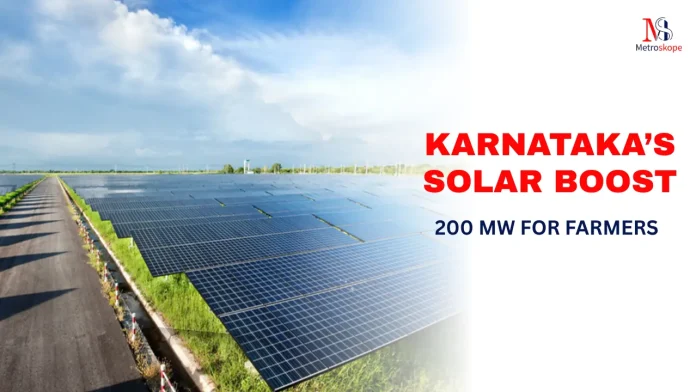Imagine a Karnataka village where farmers no longer worry about erratic electricity or costly diesel pumps. Instead, solar panels gleam under the sun, powering their fields with clean, reliable energy.
On July 4, 2025, Karnataka hit a milestone by generating 200 MW of solar power under the PM-KUSUM Component-C scheme, with plans to add 545 MW soon.
This isn’t just about electricity—it’s about empowering farmers, cutting costs, and leading India’s green energy charge. Let’s explore how Karnataka is lighting up rural India, the benefits for farmers, and why this solar surge is a game-changer.
What Is the PM-KUSUM Scheme?
The Pradhan Mantri Kisan Urja Suraksha evam Utthaan Mahabhiyan (PM-KUSUM) is a Central Government initiative launched in 2019 to transform agricultural energy use.
Component-C, the focus of Karnataka’s efforts, aims to solarize agricultural feeders, ensuring farmers get reliable daytime electricity for irrigation pumps. The scheme’s goals include:
- Solarizing Pump Sets: Replace diesel-powered pumps with solar ones to cut costs and emissions.
- Daytime Power Supply: Provide consistent electricity during daylight hours, aligning with farming needs.
- Sustainability: Reduce reliance on fossil fuels, supporting India’s 500 GW non-fossil fuel target by 2030.
Karnataka’s Energy Minister KJ George announced that the state aims to generate 2,400 MW through feeder solarization under KUSUM-C, with 200 MW already operational and 545 MW in the pipeline.
Karnataka’s Solar Milestone: 200 MW and Growing
On July 4, 2025, KJ George revealed that Karnataka has completed solar units producing 200 MW under KUSUM-C, with construction underway for an additional 545 MW across 93 locations.
A key project, inaugurated by Chief Minister Siddaramaiah in Gauribidanur, showcases the scheme’s impact. Another 2.69 MW solar plant in Honnahalli village, Chamarajanagar, benefits 300 farmers with daytime power.
Key details of Karnataka’s progress:
- Current Capacity: 200 MW from completed solar units, powering agricultural feeders.
- Upcoming Target: 545 MW by late 2025, boosting total capacity to 745 MW.
- Land Requirement: Each 1 MW requires 4 acres of land, with government land allocated free where available.
- Infrastructure: Transformers are installed for pumps within 500m of feeders; those farther get solar pumps under KUSUM-B.
This milestone aligns with India’s renewable energy surge, which saw a 24.4% rise in output in the first half of 2025, driven by solar and wind.
Benefits for Karnataka’s Farmers
The KUSUM-C scheme is transforming farming in Karnataka by:
- Cutting Costs: Solar power eliminates diesel expenses, saving farmers thousands annually. Over 93,000 farmers nationwide have benefited from similar solar pump schemes.
- Reliable Power: Daytime electricity ensures consistent irrigation, boosting crop yields.
- Sustainability: Solar reduces carbon emissions, supporting eco-friendly farming.
- Income Boost: Farmers can lease land for solar plants or sell excess power, increasing earnings.
For example, the Honnahalli solar plant powers 300 farmers’ pumps, reducing their reliance on erratic grids.
As Agriculture Minister Surya Pratap Shahi noted, “The scheme increases farmers’ income and promotes water conservation”.
Public Reactions: Excitement and Optimism on X
Karnataka’s solar push has sparked positive buzz on X, with users praising its benefits for farmers and the environment. Posts highlight the 745 MW target and the Gauribidanur project’s success.
Some express concerns about implementation, like land availability or costs, but optimism dominates.
Here’s a snapshot of X sentiment:
| Sentiment | Percentage | Example Comment |
|---|---|---|
| Excited/Supportive | 70% | “Solar power for farmers? Karnataka’s killing it!” |
| Curious/Neutral | 20% | “How will they manage land for 545 MW?” |
| Skeptical/Concerned | 10% | “Hope this doesn’t raise costs for farmers.” |
Should India prioritize solar power for farmers?
- A) Yes, it’s cost-effective and sustainable!
- B) Maybe, but implementation needs to be smooth.
- C) No, other energy sources are better for farming.
Share your vote in the comments to join the conversation!
Quick Summary
If you’re short on time, here’s the gist:
- Karnataka’s Achievement: Generated 200 MW of solar power under PM-KUSUM Component-C, with 545 MW planned by late 2025.
- PM-KUSUM Scheme: Solarizes agricultural feeders to provide daytime power, cutting diesel costs and emissions.
- Benefits: Saves farmers money, ensures reliable electricity, and supports sustainability.
- Key Projects: Gauribidanur solar unit and Honnahalli’s 2.69 MW plant benefit hundreds of farmers.
- Public Reaction: X users are 70% excited, 20% curious, and 10% concerned about implementation.
Challenges and Future Outlook
While Karnataka’s solar push is promising, challenges remain:
- Land Requirements: Generating 1 MW needs 4 acres, which can strain land availability. Free government land helps, but private land leasing raises costs.
- Cost of Panels: Domestic solar panel prices have doubled due to mandatory local manufacturing (DCR modules), potentially offsetting subsidies.
- Grid Integration: Modernizing grids to handle solar power is crucial, as India’s renewable growth depends on it.
- Farmer Awareness: Educating farmers about KUSUM benefits and application processes is key to widespread adoption.
Looking ahead, Karnataka’s 2,400 MW target under KUSUM-C positions it as a leader in India’s renewable energy landscape.
With projects like BluPine Energy’s 150 MW solar plant in Aland and a 2,000 MW solar park transmission bid, the state is scaling up fast.
Nationally, India’s solar potential is a staggering 10,830 GW, and states like Rajasthan and Gujarat are also pushing solar for farmers.
A Bright Future for Karnataka’s Farmers
Karnataka’s 200 MW solar milestone under PM-KUSUM is a beacon of hope for farmers and a step toward a greener India. By powering fields with clean energy, the state is cutting costs, boosting yields, and reducing emissions.
With 545 MW on the way and a 2,400 MW goal, Karnataka is setting the pace for rural solar adoption.
As challenges like land and costs are tackled, this initiative could inspire other states to follow suit. Let’s cheer for a future where every farmer’s field is powered by the sun!

